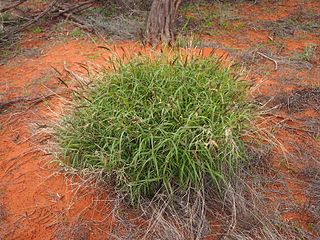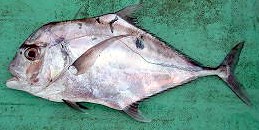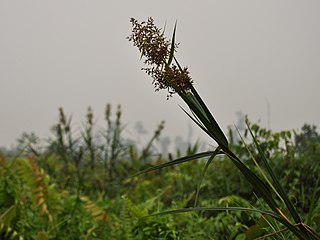
Cynodon is a genus of plants in the grass family. It is native to warm temperate to tropical regions of the Old World, as well as being cultivated and naturalized in the New World and on many oceanic islands.

Cenchrus ciliaris is a species of grass native to most of Africa, southern Asia, southern Iran, and the extreme south of Europe (Sicily). Other names by which this grass is known include dhaman grass, anjan grass, koluk katai and buffelgrass.

Cenchrus is a widespread genus of plants in the grass family. Its species are native to many countries in Asia, Africa, Australia, the Americas, and various oceanic islands.

Ipomoea pes-caprae, also known as bayhops, bay-hops, beach morning glory, railroad vine or goat's foot, is a common pantropical creeping vine belonging to the family Convolvulaceae. It grows on the upper parts of beaches and endures salted air. It is one of the most common and most widely distributed salt tolerant plants and provides one of the best known examples of oceanic dispersal. Its seeds float and are unaffected by salt water.

The African pompano, also known as the pennant-fish or threadfin trevally, is a widely distributed species of tropical marine fish in the jack family, Carangidae. The species is found in tropical waters worldwide, with adults often inhabiting coastlines, while juveniles are usually pelagic, floating with ocean currents. The adult African pompano is similar in appearance to the other members of the genus Alectis, with the concave shape of the head near the eyes; the clearest distinguishing feature. The juveniles are similar to other members of Alectis, having long, filamentous dorsal and anal fin tips which are thought to discourage predators. The species lives in depths less than 100 m, consuming a range of crustaceans and small fishes. The species is of minor economic importance, often taken amongst other tropical midwater fishes by hook and line, while juveniles are occasionally caught in beach seines. African pompano are also highly rated game fish, often considered one of the strongest of the jacks in larger sizes.

Scleria is a genus of flowering plants in the sedge family, Cyperaceae. They are known commonly as nutrushes. They are distributed throughout the tropics, and some species have ranges extending into temperate areas. There are about 200 species.

Brachyachne is a genus of African, Australian, and Southeast Asian plants in the grass family.
Microchloa, or smallgrass, is a genus of tropical and subtropical plants in the grass family, native to Africa, southern Asia, northern Australia, and the warmer parts of the Western Hemisphere.
Telicota eurotas, the sedge darter, is a butterfly of the family Hesperiidae. It is found in Australia, the Aru Islands, Irian Jaya, Maluku and Papua New Guinea.

Scleria sumatrensis, commonly known as nutrush and Sumatran scleria, is a plant species in the sedge family. It is native to temperate and tropical Asia, where it is usually found growing in wetlands, and is considered a noxious weed on the island of Borneo. It has been used in traditional medicine against gonorrhea.
Scleria bracteata, the bracted nutrush, is a plant in the family Cyperaceae. It grows as a perennial climber.
Scleria iostephana is a plant in the family Cyperaceae. It grows as a stout perennial sedge up to 2 metres high.

Scleria mackaviensis is a plant in the family Cyperaceae. It grows as a tufted sedge.
Scleria mikawana is a plant in the family Cyperaceae. It grows as a tall, slender annual sedge.

Melanthera biflora also known as sea daisy, beach daisy and sea ox-eye, is a species of flowering plant in the family Asteraceae. It is a scandent, rough-looking and fast-growing plant with a wide distribution.

Digitaria ciliaris is a species of grass known by the common names southern crabgrass, tropical finger-grass, tropical crabgrass or summer grass.
Eragrostis ciliaris, the gophertail lovegrass, is a species of grass. It is native to the Old World Tropics; nearly all of Africa, Madagascar, other Indian Ocean islands, the Arabian Peninsula, the Indian Subcontinent, Myanmar, Vietnam, Taiwan and the Philippines and a number of Pacific islands, and has been introduced to the New World Tropics and Subtropics, from the southern United States to Argentina, the Caribbean, and other Pacific islands. Its seeds are edible and nutritious, but quite small and difficult to harvest and handle, so it is usually regarded as a famine food.

Selaginella ciliaris is a plant in the family Selaginellaceae which is native to areas from India and Nepal eastwards to China and Taiwan, and south to northern Australia.












